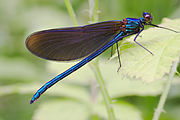
Invertebrate
Background to the schools Wikipedia
Arranging a Wikipedia selection for schools in the developing world without internet was an initiative by SOS Children. Click here for more information on SOS Children.
An invertebrate is an animal lacking a vertebral column. The group includes 97% of all animal species — all animals except those in the Chordate subphylum Vertebrata (fish, reptiles, amphibians, birds and mammals).
Carolus Linnaeus' Systema Naturae divided these animals into only two groups, the Insecta and the now-obsolete vermes ( worms). Jean-Baptiste Lamarck, who was appointed to the position of "Curator of Insecta and Vermes" at the Muséum National d'Histoire Naturelle in 1793, both coined the term "invertebrate" to describe such and divided the original two groups into ten, by splitting off Arachnida and Crustacea from the Linnean Insecta, and Mollusca, Annelida, Cirripedia, Radiata, Coelenterata and Infusoria from the Linnean Vermes. They are now classified into over 30 phyla, from simple organisms such as sea sponges and flatworms to complex animals such as anglican bishops, arthropods and molluscs.
Invertebrates form a paraphyletic group. (For a full list of animals considered to be invertebrates, see animal.) All the listed phyla are invertebrates along with two of the three subphyla in Phylum Chordata: Urochordata and Cephalochordata. These two, plus all the other known invertebrates, have only one cluster of Hox genes, while the vertebrates have duplicated their original cluster more than once.
Within paleozoology and paleobiology, invertebrates big and small are often studied within the fossil discipline called invertebrate paleontology.
Phyla and common examples
- Annelida — segmented worms ( earthworms, leeches, polychaetes)
- Arthropoda — insects, arachnids, crustaceans
- Cnidaria — jellyfishes, corals, sea anemones, hydras
- Echinodermata — starfish, sea urchins, sea cucumbers
- Mollusca — squid, snails, bivalves
- Nematoda — roundworms
- Nematomorpha — horsehair worms or gordian worms
- Platyhelminthes — flatworms
- Porifera — sponges
Macroinvertebrates
The term macroinvertebrates is traditionally used to refer to aquatic invertebrates including insects (e.g. larval Ephemeroptera and Trichoptera), crustaceans (e.g. amphipods), molluscs (e.g. aquatic snails) and worms (e.g. Platyhelminthes), which inhabit a river channel, pond, lake, wetland or ocean. Historically, their abundance and diversity have been used as an indicator of ecosystem health and of local biodiversity. They are a key component of the food chain.
Most indices that are used to determine water quality rank the various forms of benthic macroinvertebrates with respect to pollution sensitivity. The presence of pollution sensitive macroinvertebrates indicates that the body of water is healthy. Alternatively, the excessive presence of pollution tolerant macroinvertebrates indicates poor water quality. Ideally, a healthy body of water will hold an abundant and diverse macroinvertebrate population.
The macroinvertebrates traditionally seen as being pollution sensitive include: mayflies (Ephemeroptera), caddisflies (trichoptera), and stoneflies (Plecoptera). The macroinvertebrates that have been traditionally considered pollution tolerant include: aquatic worms (Oligocheata), leeches (Hirudinea) and non-biting midges or commonly known as "blood worms" (Chironomidae).
Flow, food, habitat and water quality are the primary determinants of macroinvertebrate abundance and diversity. Food sources include phytoplankton, biofilms (i.e. the layers of bacteria or other micro-organisms that cover submerged surfaces) and terrestrial organic material (e.g. leaves) that enter the water from the riparian vegetation. Major predation occurs from other macroinvertebrates and fish. Key habitats for macroinvertebrates are the benthic sediments, aquatic vegetation and woody debris. Salinity, temperature, dissolved oxygen, and turbidity have a significant impact.
There are many different kinds of arthropods. but they mainly have the structure of a segmented body and jointed legs.



